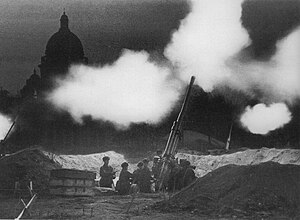Siege of Leningrad
| Siege of Leningrad | |||||||||
|---|---|---|---|---|---|---|---|---|---|
| Part of The Eastern Front of World War II | |||||||||
 Soviet antiaircraft battery in Leningrad near Saint Isaac's Cathedral, 1941 | |||||||||
| |||||||||
| Belligerents | |||||||||
|
| |||||||||
| Commanders and leaders | |||||||||
| Strength | |||||||||
| Initial: 725,000 | Initial: 930,000 | ||||||||
| Casualties and losses | |||||||||
|
1941: 85,371 total casualties[4] 1942: 267,327 total casualties[5] 1943: 205,937 total casualties[6] 1944: 21,350 total casualties[7] Total: 579,985 casualties |
Baltic Fleet: 55,890 Leningrad Front: 467,525 Total: 523,415 | ||||||||
|
Soviet civilians: 642,000 during the siege, 400,000 at evacuations[8] | |||||||||
The siege of Leningrad was a siege in Leningrad during World War II.[10] The siege started on 8 September 1941, when the last road to the city was severed.

Although the Soviet Union forces managed to open a narrow path to the city on 18 January 1943, the siege was only stopped on 27 January 1944, 872 days after it began. It is thought of as one of the most destructive sieges ever to happen. It was possibly the heaviest in terms of casualties, killing over 1 million innocent people. Also, because of the siege, no food was allowed to enter Leningrad, leaving the residents to eat things such as:
- Cats
- Sawdust
- Horses
- Wallpaper paste
- Human flesh (e.g babies)
- Anything that could be salvaged and was edible
Because of the German operations, no people or supply trucks were allowed to enter or leave the city, leaving the occupants without food often for weeks or months.[11] Sometimes in winter an "ice road" operated on the ice of Lake Ladoga, bringing some food and supplies into the city and evacuating some civilians and wounded soldiers.
Related pages
[change | change source]References
[change | change source]- ↑ Brinkley & Haskew 2004, p. 210
- ↑ Wykes 1972, pp. 9–21
- ↑ Baryshnikov 2003; Juutilainen 2005, p. 670; Ekman, P-O: Tysk-italiensk gästspel på Ladoga 1942, Tidskrift i Sjöväsendet 1973 Jan.–Feb. Archived 4 March 2016 at the Wayback Machine, pp. 5–46.
- ↑ "Heeresarzt 10-Day Casualty Reports per Army/Army Group, 1941". Archived from the original on 25 October 2012. Retrieved 28 March 2012.
- ↑ "Heeresarzt 10-Day Casualty Reports per Army/Army Group, 1942". Archived from the original on 28 December 2015. Retrieved 24 March 2015.
- ↑ "Heeresarzt 10-Day Casualty Reports per Army/Army Group, 1943". Archived from the original on 25 May 2013. Retrieved 25 May 2013.
- ↑ "Heeresarzt 10-Day Casualty Reports per Army/Army Group, 1944". Archived from the original on 29 October 2012. Retrieved 3 May 2012.
- ↑ 8.0 8.1 8.2 Glantz 2001, pp. 179
- ↑ Krivosheev, G. F. (1997). Soviet Casualties and Combat Losses in the Twentieth Century. ISBN 9781853672804. Archived from the original on 18 January 2023. Retrieved 3 October 2020.
- ↑ Andrews, Evan. "The Siege of Leningrad". HISTORY. Retrieved 2021-05-20.
- ↑ Network, Warfare History (2020-09-13). "How Leningrad Survived the Siege". The National Interest. Archived from the original on 2021-07-24. Retrieved 2021-05-20.
